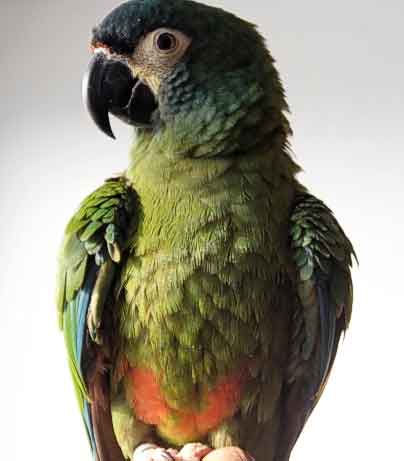
Primolius maracana (*)
Superregnum: Eukaryota
Cladus: Unikonta
Cladus: Opisthokonta
Cladus: Holozoa
Regnum: Animalia
Subregnum: Eumetazoa
Cladus: Bilateria
Cladus: Nephrozoa
Superphylum: Deuterostomia
Phylum: Chordata
Subphylum: Vertebrata
Infraphylum: Gnathostomata
Megaclassis: Osteichthyes
Cladus: Sarcopterygii
Cladus: Rhipidistia
Cladus: Tetrapodomorpha
Cladus: Eotetrapodiformes
Cladus: Elpistostegalia
Superclassis: Tetrapoda
Cladus: Reptiliomorpha
Cladus: Amniota
Classis: Reptilia
Cladus: Eureptilia
Cladus: Romeriida
Subclassis: Diapsida
Cladus: Sauria
Infraclassis: Archosauromorpha
Cladus: Crurotarsi
Divisio: Archosauria
Cladus: Avemetatarsalia
Cladus: Ornithodira
Subtaxon: Dinosauromorpha
Cladus: Dinosauriformes
Cladus: Dracohors
Cladus: Dinosauria
Cladus: Saurischia
Cladus: Eusaurischia
Subordo: Theropoda
Cladus: Neotheropoda
Cladus: Averostra
Cladus: Tetanurae
Cladus: Avetheropoda
Cladus: Coelurosauria
Cladus: Tyrannoraptora
Cladus: Maniraptoromorpha
Cladus: Maniraptoriformes
Cladus: Maniraptora
Cladus: Pennaraptora
Cladus: Paraves
Cladus: Eumaniraptora
Cladus: Avialae
Infraclassis: Aves
Cladus: Avebrevicauda
Cladus: Pygostylia
Cladus: Ornithothoraces
Cladus: Ornithuromorpha
Cladus: Carinatae
Parvclassis: Neornithes
Cohors: Neognathae
Cladus: Neoaves
Cladus: Telluraves
Cladus: Australaves
Ordo: Psittaciformes
Familia: Psittacidae
Subfamilia: Arinae
Tribus: Arini
Genus: Primolius
Species: Primolius maracana
Name
Primolius maracana (Vieillot, 1816)
Synonymy
Macrocercus maracana (protonym)
Synonyms
Propyrrhura maracana
References
Vieillot, L.P. 1816. Nouveau Dictionnaire d’Histoire naturelle, appliquée aux arts, à l'agriculture, à l'économie rurale et domestique, à la médecine, etc. Par une société de naturalistes et d'agriculteurs. Avec des figures tirées des trois règnes de la nature. Tome 2. 592 pp. +11 tt. Déterville, Paris. p. 260 BHL Reference page.
Links
IUCN: Primolius maracana (Near Threatened)
Listed animal in CITES Appendix I
Vernacular names
български: Синьокрил ара
čeština: Ara marakána
Cymraeg: Macaw Illiger
Deutsch: Rotrückenara
English: Blue-winged Macaw
español: Guacamayo maracaná
فارسی: مکائو بالآبی
suomi: Brasilianara
français: Ara d'Illiger
magyar: Marakánaara
кырык мары: Симсӹ шылдыран ара
Nederlands: Illigers ara
norsk: Rødbukara
پنجابی: نیل پرا میکاع
português: Maracanã-verdadeiro
русский: Красноспинный ара
svenska: blåvingad ara
اردو: نیل پر مکاؤ
中文: 藍翅金剛鸚鵡
The blue-winged macaw (Primolius maracana), in aviculture more commonly known as Illiger's macaw, is a species of small macaw (sometimes called a mini-macaw) found in central and eastern South America. The second name is in honor of the German ornithologist Johann Karl Wilhelm Illiger.[3] It was previously placed in the genera Ara or Propyrrhura. Blue-winged macaws have been known to reach an age of 50–60 years.
Description
It has a total length of approximately 36–43 cm (14–17 in). It has a moderately sized black bill, a long tail and a mainly green plumage. The upperside of the remiges and primary coverts are blue, as indicated by its common name. The underside of the wings is yellowish, the tail-tip, crown and cheeks are bluish, and the tail-base and small belly-patch are red. The iris is amber. It and the red-bellied macaw are the only macaws where the bare facial-skin is yellowish, but this often fades to white in captivity. Unlike the red-bellied macaw, the blue-winged has a red lower abdomen and a red lower back.[4] In the wild, its flight pattern is said to be a distinctive 'jerky, rearing motion.' [3]
Habitat and food
The blue-winged macaw occurs in eastern and southern Brazil (with a remnant population north-east), eastern Paraguay and, at least formerly, in far north-eastern Argentina and east of Bolivia. It occurs in evergreen and deciduous forests, with a preference for gallery forest. They mainly feed on seeds of Cnidoscolus phyllacanthus, Jatropha, Guazuma ulmifolia, and the non-native Melia azedarach. However, the birds also feed on fruits and nuts.
Breeding
The blue-winged macaw attain sexual maturity between 2 and 4 years after they are born. Adult females usually produce two eggs which take approximately 29 days to hatch. Young blue-winged macaws learn to fly about 11 weeks after they have hatched. They stay with their parents for about a year after learning to fly. Relatively little information exists on its reproduction in the wild, but the breeding season in north-eastern Brazil is apparently from December to February. However, in 1990, a female blue-winged macaw was discovered with a male Spix's macaw in a site.
Threats
These birds are affected mostly by deforestation. They were also captured for the cagebird trade - from 1977 to 1979, 183 birds arrived at the United States from Paraguay. It has declined in the southern part of its range, and there are no recent records from Misiones Province in Argentina where many were killed by farmers who considered them pests.[5] Therefore, it was previously considered vulnerable. Information from Brazil suggests it remains widespread and has even re-colonised areas in its historical range in southern Rio de Janeiro. This has led to it being downlisted to near threatened.
Aviculture
The blue-winged macaw is sometimes kept by humans as an aviary bird or companion parrot. An intensely social bird and a strong flier, this macaw does best when housed with other birds (whether other blue-winged macaws or member of a different parrot species) and given plenty of space in which to fly. It is also an avid chewer and may damage its keeper's property unless provided with wooden destructible objects to occupy its time. Captive breeding of this species is encouraged, due to conservation concerns.[6] If kept as a pet, the blue-winged macaw can bond strongly with humans and some individuals may even begin to mirror their owner's emotional state.[7]
References
BirdLife International (2016). "Primolius maracana". IUCN Red List of Threatened Species. 2016: e.T22685606A93081612. doi:10.2305/IUCN.UK.2016-3.RLTS.T22685606A93081612.en. Retrieved 11 November 2021.
"Appendices | CITES". cites.org. Retrieved 2022-01-14.
Forshaw, Joseph Michael (1977) [1973]. Parrots of the world. Cooper, William T. (illustrator). Neptune, N.J.: T.F.H. ISBN 0876669593. OCLC 10506541.
"Species factsheet: Primolius maracana". BirdLife International (2008). Retrieved 24 July 2008.
Bodrati, A., K. Cockle, J. I. Areta, G. Capuzzi, and R. Farina. 2006. El maracana lomo rojo (Primolius maracana) en Argentina: de plaga a la extincion en 50 anos? El Hornero 21: 37-43
"Illiger's or Blue-winged Mini-Macaws as Pets". Beauty of Birds. 16 September 2021. Retrieved 13 March 2022.
Kalhagen, Alyson. "Illiger's Macaw (Blue-Winged Macaw): Bird Species Profile". The Spruce Pets. Retrieved 13 March 2022.
ANIMAL BYTES - Illiger's Macaw
http://www.arthurgrosset.com/sabirds/blue-wingedmacaw.html
Retrieved from "http://en.wikipedia.org/"
All text is available under the terms of the GNU Free Documentation License

